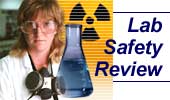Lab Safety Review: Danger! - Peroxides Present

By Wes Kolar

Lab Safety Review is a monthly column on Laboratory Network.com. Each edition is written by a specialist in this important field.
Hazard Levels Vary
Classification
Precautions to Take
References
Organic peroxides are potentially explosive solids that form in many common organic liquids found in the laboratory. These shock, heat, or friction-sensitive compounds usually form upon exposure of the host organic liquid to air, heat, light, or contamination. The relative danger associated with a peroxide-forming chemical depends on the rate of peroxide formation, the stability of the peroxide, and the volatility of the host chemical.
Hazard Levels Vary (Back to Top)
The peroxide level considered to be dangerous varies from chemical to chemical, and with the stability of the peroxide formed. In some instances, a concentration as low as 100 ppm of organic peroxide is considered to constitute a potentially dangerous mixture (1). Peroxide levels are fairly simple to test, but for safety reasons such testing should only be carried out by a qualified professional.
Volatile peroxide-forming chemicals are generally more dangerous that non-volatile ones; this is because evaporation of the host reagent results in the concentration of any peroxides that are present. For that reason the distillation of peroxide-forming solvents (such as anhydrous ether or THF) must not be carried out until peroxide levels have been determined by an expert.
Explosive levels of peroxides may also be formed by evaporation of a solvent under the cap of a bottle and around the threads. When employing peroxide forming chemicals, laboratory personnel should take care to wipe off the cap before they place it back on the bottle. Alternatively, they can rinse the cap with water in order to dissolve any peroxides present.
Classification (Back to Top)
Peroxide-forming chemicals are typically divided into three groups, A, B, and C; the classification depends upon the nature of formation of the peroxide species.
Group A contains chemicals that may form explosive levels of peroxides even in the absence of solvent evaporation. Group A peroxide-forming reagents are clearly the most dangerous of the three groups, as explosive levels may be obtained without such human assistance as leaving a cap off of a container. In some instances, group A peroxide-forming chemicals have reached explosive levels over time even though the bottle had never been opened. Fortunately, only a few group A peroxide forming species are known to exist. The group A reagents most commonly encountered on the University of Georgia campus are sodium amide, isopropyl ether, and potassium metal. As with all chemicals employed in the laboratory, group A peroxide-forming chemicals should be dated upon receipt and upon opening. They should be stored away from heat and light and should be kept for no longer than three months after they are opened.
Group B consists of chemicals that may form explosive levels of peroxides as a result of concentration due to evaporation of the host reagent. Several common organic solvents fall into group B, including diethyl (anhydrous) ether, tetrahydrofuran (THF), 1,4 dioxane (para dioxane), cyclohexene, and 2-propanol (isopropyl alcohol). Group B peroxide-forming chemicals should be stored away from heat and light, and should be kept in a lab for no longer than 12 months after they are opened.
Group C consists of monomers that may polymerize violently or explosively as a result of the presence of peroxides. Common group C peroxide-forming species include butadiene, styrene, vinyl chloride, and tetrafluoroethylene. As with group B, group C peroxide-forming chemicals should be stored for no longer than 12 months after they are opened.
Precautions to Take (Back to Top)
If you find old or outdated peroxide-forming chemicals in your laboratory, please contact the Hazardous Materials Treatment Facility (HMTF) at 706-369-5706. Disposal procedures are generally simple and free of charge. Materials suspected of containing peroxides should not be moved, disturbed, or opened until the dangers can be properly assessed. Additional information on peroxide forming chemicals can be obtained through HMTF, or through the laboratory safety group of the Environmental Safety Division at 706-542-5801. Several excellent reviews outline the dangers associated with organic peroxides, along with storage recommendations for many chemicals (1-3).
- Kelly, R. J.; “Review of Safety Guidelines for Peroxidizable Organic Chemicals”; Chemical Health and Safety, September/October, 1996, pp. 28 - 36.
- Wray, T. K.; “Danger: Peroxidizable Chemicals”; Hazmat World, November, 1992, pp. 48 - 49.
- Jackson, H. L.; McCormack W. B.; Rondestvedt, C. S.; Smeltz, K. D.; Viele, I. E.; “Control of Peroxidizable Compounds”; Journal of Chemical Education, March 1970, pp. A175- A188.
About the Author
Wes Kolar is the Hazmat Operations Coordinator, University of Georgia.
For more information: Wesley Kolar, Hazmat Operations Coordinator, Office of the Vice President for Research, University of Georgia, 222 Tucker Hall, 310 East Campus Rd., Athens, GA, 30602, wkolar@uga.edu
